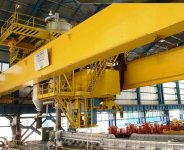dondon_alba
Member
Hi All,
What would be the cause of heavy jerking of our crane during long travel operation? Here is the scenario;
What really puzzled me is that, we have two identical cranes, the same type of VFD, the same parameter settings, the same motors but the other crane is working smoothly and precisely, no jerking, no shaking, no vibration, no nothing.
Could this be a problem of mechanical backlash or the crane requires stiffening on mechanical parts. In need of your help
Thank you,
Don
What would be the cause of heavy jerking of our crane during long travel operation? Here is the scenario;
- The time I issued a command to start and the crane started accelerating and ramping up the speed a heavy jerk is observed, once it’s picking up the speed till it reached to maximum speed it runs very smoothly.
- During stopping it did the same thing and vice versa.
What really puzzled me is that, we have two identical cranes, the same type of VFD, the same parameter settings, the same motors but the other crane is working smoothly and precisely, no jerking, no shaking, no vibration, no nothing.
Could this be a problem of mechanical backlash or the crane requires stiffening on mechanical parts. In need of your help
Thank you,
Don










